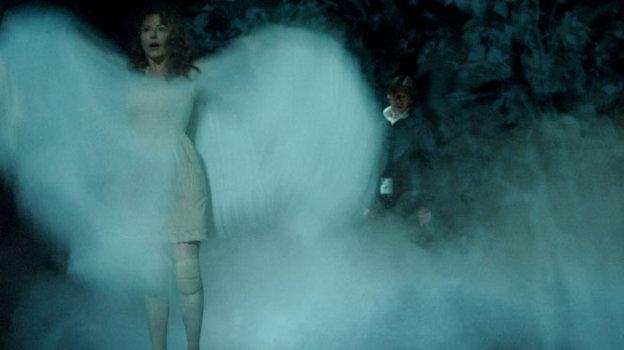
At a time of year when all things Gothic crawl out from the woodwork, it can be difficult to find a theatrical offering that presents what is very familiar in a unique or interesting way. TR Warszawa’s Nosferatu is thankfully doing just that with its interpretation of Bram Stoker’s Dracula, a well-worn text if ever there was one. The renowned Polish theatre company have produced a seductive piece that explores the relationship between ideas and reality, and the place where temptation and fear flutter nervously together in the interplay between light and dark.
The first scene opens on the cast spread out across the sumptuously designed stage, the frankly outstanding lighting casting an eerie pallor over them as they discuss the possibility of a particle moving faster than the speed of light. The tone of the piece soon makes it clear that this is not going to be a standard drama: everything is just a little strange. Lucy, the object of Nosferatu’s dark desire, emits an aura of peculiarity as she floats across the stage seemingly half asleep, delivering lines in a breathy sigh.
Then director Grzegorz Jarzyna makes a clear statement regarding how we are to begin watching the piece by placing several moments of still silence in the early scenes. For what feels like minutes we watch as Lucy sleeps, the passing of time marked by the soft billowing breath of the curtains as they flutter at the side of the stage, and by the gently shifting light which changes by near imperceptible degrees as the day passes. The effect is utterly dreamlike; perhaps in any other production I might have been bored but here there was an electric atmosphere bubbling beneath the surface that left me unable to take my eyes away from the stage.
The Unreal then slowly invades the production as Nosferatu makes his entrance, dry ice creeps out from the curtains, and Lucy is seemingly seduced by the smog. The tension on stage continues to build as the play progresses, the horror mingling with sexuality as Nosferatu and Lucy intertwine in their dark embrace and Lucy’s naked corpse is later examined by the doctor. The resulting arousal of the senses in the audience is very effective. The lighting too undergoes a journey as shadows are thrown across the stage and light is reflected, continually playing with what is real and what is a mere reflection. In one theatrical moment that I shall never forget, gauze was dropped across the stage and projection put to utterly scintillating use, leaving me completely unable to discern what was real and what was not as ash white roses bloomed from the smog and climbed high into the air in front of my eyes.
Gradually the characters in the piece are all destroyed by Nosferatu’s presence – seduced, sent mad or murdered. The stage also reflects the gradual decline into the abyss as the once detailed set slowly disappears one piece at a time, until eventually a bare stage is all that is left.
Nosferatu does not seem very intent on clear storytelling or escalating pace; rather like the dark prince himself it draws you in, seduces you, and in a dream-like state you find yourself embraced by the eerie atmosphere. It’s a visually stunning piece with impeccable design and some of the best lighting I’ve ever seen put to use. The cast, as well, are excellent and the direction is brave and poignant, casting a spell over the audience that lingered long after I had disappeared into the night.

